Home brewing apple cider is surprisingly easy and you don’t need to buy a lot of expensive equipment. However most of the articles you see on the web on brewing Apple cider use a press. The instructions below use a ‘juicer machine’ instead and works just as well, plus it’s more likely that you have one of these than a press!
The instructions below use a technique that replaces the natural yeast that forms part of the Apple juice with your own. This can give you more control over the process and may reduce the risk of a bad batch. That said however the process can work equally well by using the natural yeasts in the juice. If you prefer this simply skip the steps that kill off the natural yeasts and replace them with your own yeast of choice.
Choice of Apples…
Cider quality inevitably depends on the type of apples you use. Cider is traditionally made with one third each of sweet, bittersweet, and sharp apples. The principle characteristics of cider apples which contribute to this classification are the content tannins and the acidity. Bittersweet apples contain more than 0.2% (w/v) of tannins and less than 0.45% (w/v) acidity (calculated as malic acid). Sharp apples have less than 0.2% (w/v) tannins and greater than 0.45% (w/v) acidity; a subgroup of this classification, bittersharps, have the same range of acidity but have a tannin content of greater than 0.2% (w/v). Sweet apples have less than 0.2% (w/v) tannins and less than 0.45% (w/v) acid.
Apples According to TypeYou will see from the lists that there are far fewer varieties of bitterweet apples than of any other type, however, if you are making single variety apple cider, these are the apples you would use to achieve the best cider. Most modern cider makers making cider in the traditional manner will use one or more varieties of bittersweet apples.
<span style='font-size:normal;font-weight:bold;'>Bittersweet Apples</span>
| Brown Snout | Improved Dove |
| Chisel Jersey | Knotted Kernel |
| Dabinette | Somerset Red |
| Fillbarrel | Tramlett’s Bitter |
| Harry Master’s Jersey | Yarlington Mill |
| Kingston Black |
<span style='font-size:normal;font-weight:bold;'>Sharp or Bittersharp Apples</span>
| Alfriston | Carlisle Codlin |
| Beauty of Kent | Caroline |
| Baxter’s Pearmain | Castle Major |
| Bedfordshire Foundling | Catshead |
| Betty Geeson | Cellini |
| Blenheim Pippin | Cole |
| Brabant Bellefleur | Cox’s Pomona |
| Broad-eyed Pippin | Duchess of Oldenburgh |
| Brown Kenting | Dumelow’s Seedling |
| Brownlee’s Russet | Dredge’s Fame |
| Browns Apple | Dutch Codlin |
| Early Julyan | Greenup’s Pippin |
| Ecklinville | Hambledon Deux Ans |
| Emperor Alexander | Hanwell Souring |
| English Codlin | Harvey Apple |
| Fall Pippin | Harvey’s Pippin |
| Fearn’s Pippin | Hawthornden |
| Flower of Kent | Herefordshire Costard |
| Foxwhelp | Hoary Morning |
| Galloway Pippin | Hollandbury |
| Glory of the West | Holland Pippin |
| Gloucestershire Costard | Hoskreiger |
| Golden Noble | Keswick Codlin |
| Grand Duke Constantine | Kentish Pippin |
| Grange’s Pearmain | Kentish Fill-Basket |
| Lady Henniker | Moore’s Seedling |
| Lane’s Prince Albert | Melrose |
| Loddington | Mere de Menage |
| London Pippin | Minchull Crab |
| Lord Derby | Minier’s Dumpling |
| Lord Grosvenor | Mitchelson’s Seedling |
| Lord Suffield | |
| Lucombe’s Seedling | |
| Nelson Codlin | Red Hawthornden |
| Nonesuch | Reinette du Canada |
| Norfolk Beefing | Rhode Island Greening |
| Northern Greening | Round Winter Nonesuch |
| Norfolk Stone Pippin | Royal Pearmain |
| Omar Pasha | Royal Russet |
| Pile’s Russet | Royal Somerset |
| Porters Perfection | Rymer |
| Rabine | |
| Small’s Admirable | Toker’s Incomparable |
| Springrove Codlin | Tom Putt |
| Stamford Pippin | Tower of Glammis |
| Stirling Castle | William’s Favourite |
| Striped Beefing | Winter Codlin |
| Sugarloaf Pippin | Winter Colman |
| Summer Pearmain | Winter Greening |
| Summer Stibbert | Winter Hawthornden |
| Sweeny Nonpareil | Winter Pearmain |
| Waltham Abbey Seedling | Winter Quoining |
| Wadhurst Pippin | Winter Majetin |
| Warner’s King | Yorkshire Greening |
| Watson’s Dumpling |
<span style='font-size:normal;font-weight:bold;'>Sweet Apples</span>
| Aromatic Russet | Cockle’s Pippin |
| Ashmead’s Kernel | Coe’s Golden Drop |
| Barcelona Pearmain | Cornish Aromatic |
| Barton’s Incomparable | Cornish Gilliflower |
| Beachamwell | Court Pendu Plat |
| Borsdorfer | Court of Wick |
| Boston Russet | Cox’s Orange Pippin |
| Bowyer’s Russet | Crofton Scarlet |
| Braddick’s Nonpareil | D’Arcy Spice |
| Breedon Pippin | Devonshire Quarrenden |
| Brickley Seedling | Downton Pippin |
| Brooke’s | Duke of Devonshire |
| Broughton | |
| Byson Wood Russet | |
| Early Harvest | Harvey’s Wiltshire Defiance |
| Early Nonpareil | Holbert’s Victoria |
| Eldon Pippin | Hornmead Pearmain |
| Esopus Spitzenburgh | Hubbard’s Pearmain |
| Farleigh Pippin | Hughes Golden Pippin |
| Federal Pearmain | Hunt’s Deux Ans |
| Forman’s Crew | Hunt’s Duke of Gloucester |
| Franklin’s Golden Pippin | Irish Peach |
| Golden Harvey | Isle of Wight Pippin |
| Golden Knob | Joaneting |
| Golden Nonpareil | Jonathan |
| Golden Pippin | Keddleston Pippin |
| Golden Reinette | Keeping Russet |
| Golden Russet | Kerry Pippin |
| Golden Winter Pearmain | |
| Gravenstein | |
| Lamb Abbey Pearmain | Old King of the Pippins |
| Large Yellow Bough | Ord’s |
| Loan’s Pearmain | Oslin |
| Lodgemore Nonpareil | Osterley Pippin |
| Lord Burghley | Packhorse |
| Lucombe’s Pine Apple | Padley’s Pippin |
| Margaret | Pearson’s Plate |
| Maclean’s Favourite | Pine Golden Pippin |
| Mannington’s Pearmain | Pineapple Russet |
| Margil | Pinner Seedling |
| Melon | Pennington’s Seedling |
| Morris’s Court of Wick | Pitmaston Golden Pippin |
| Morris’s Nonpareil Russet | Pitmaston Nonpareil |
| Morris’s Russet | Pitmaston Pine Apple |
| Nanny | Pomeroy of Hereford |
| New Rock Pippin | Pomme Grise |
| Nonpareil | Powell’s Russet |
| Northern Spy | |
| Red Ingestrie | Russet Table Pearmain |
| Reinette de Breda | Sack and Sugar |
| Reinette Carpentin | Sam Young |
| Reinette Diel | Scarlet Golden Pippin |
| Reinette Franche | Scarlet Nonpareil |
| Reinette Grise | Scarlet Pearmain |
| Reinette Janne Sucree | Screveton Golden Pippin |
| Reinette Van Mons | Shakespere |
| Reinette Verte | Siegende Reinette |
| Ribston Pippin | Siely’s Mignonne |
| Robinson’s Pippin | Stoke Edith Pippin |
| Rosemary Russet | Sturmer Pippin |
| Ronald’s Gooseberry Pippin | Summer Golden Pippin |
| Ross Nonpareil | Sykehouse Russet |
| Rushock Pearmain | |
| Taunton Golden Pippin | Yellow Ingestrie |
| Twining’s Pippin | Yellow Newtown Pippin |
| Uellener’s Golde Reinette | |
| Wanstall | |
| Washington | |
| Wheeler’s Russet | |
| Whorle Pippin | |
| Wormsley Pippin | |
| Wyken Pippin |
Brewing the Cider…
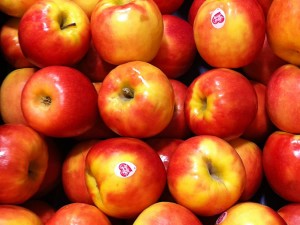
You will need the following:
- Apples (see above for the best mixtures)
- Juicer
- Sieves and muslin cloth
- Funnels
- Tubing for syphoning off
- Demijohn & airlock
- Campden tablets (to kill the yeast)
- Yeast of your choice
- Finings to clear the liquid
- Bottles to store it in
- A hydrometer to measure specific gravity and hence alcohol % is useful but NOT essential
Before you begin, it is important that any bowl or utensils used are clean and sanitary. Harmful microbes and bacteria can produce off tastes or ruin a batch of cider.
1. Prepare the apples and juice
To make about 8 litres of cider you’ll need approximately two supermarket carrier bags full of apples.
Chop the really bad bits out and cut down to whatever size is required for the juicer, then pass through the juicer.
Then using a fairly fine sieve to remove the lumps, pour the juice into a cocktail jug to collect.
Once left it will separate in the cocktail jug, sediment at bottom, yummy juice in middle and foam on top. If your cocktail jug has a mesh type pouring attachment it will help to retain most of the foam and some sediment as you pour in the next step.
Pour the contents of the cocktail jug through a muslin cloth into another bowl. You can skip the first sieve stage if you like but then your muslin will get clogged quicker.
2. Start the brewing
Once you have passed the juice through the muslin filter, pour into a demijohn. The demijohn should be cleaned with a campden tablet or similar to ensure free of contaminants. Instructions for use are on the campden tablet packet.
At this point you can leave the juice to ferment using the natural yeast in the pears but if you’re unlucky you’ll get a bad yeast in the batch.
A better way is to drop in a crushed campden tablet to kill the natural yeast and add your own yeast after a day. I tend to use champagne yeast or wheat beer yeast.
To add the yeast remove some juice and warm in a microwave to a lukewarm temp. Pour the yeast in and stir as per the packet directions then return to the demijohn.
At this point if you have a hydrometer you can read the specific gravity of the juice. A good cider tends to start around 1.055, most time I’ve found a reading of around 1.045 with apples. If desired follow the instructions on the hydrometer packed to add the correct sugar to increase to 1.055.
Then simply add the airlock and leave it. Brewing will start within a day or so and the mixture will form a foamy head. Air bubbles will escape through the airlock.
3. End of brewing
After around 2-4 weeks (will vary depending on yeast and temperature) the bubbling will stop. The yeast has used all the sugar available to turn to alcohol.
Drop in a crushed campden tablet to kill the yeast. This will drop to the bottom and the mixture will start to clear.
A day after adding the campden tablet you can add a sachet of finings to help it clear. This should be available from most brewery stores or online.
The mixture will be ready for bottling when it is almost clear enough to read through.
If available, measure the specific gravity of this finished product and follow instructions on hydrometer on how to calculate the alcohol.
4.Racking or bottling
You are now ready to bottle (rack) the cider. You should clean the bottles with a campden tablet solution as you did the original demijohn.
The best approach is to syphon off as shown. Keep the bottles approx 1 meter below the demijohn and make sure the tube inside doesn’t slip down into the sediment at bottom of the demijohn as you syphon off.
Once bottles are filled you have a chance (cider purists will hate this) to taste the cider, and if it is too dry, add some splendour or similar artificial sugar to the bottles. It will improve the sweetness and since it is artificial, will not be converted by any remaining yeast to more alcohol.
You can now bottle and label the cider. When labeling it’s a good idea to show the brewing dates, type of yeast, any sugar added and any other steps in the process taken so that if it turns out great (or terrible) you know how to repeat (or not).
That’s it, you now have cider. It can be drunk as is but is best served chilled in a few weeks or so.
Tips & Tricks for 1st timers...
If you don’t want to buy any of the equipment there a couple of things you can do to minimize outlay, until you know you want to do this more regularly …
1.Rather than buy an airlock use a balloon pierced with a safety pin. It will inflate with the gases produced from brewing which can then be release in a controlled way without letting air and harmful microbes in.
Rather than buy a demijohn consider purchasing a 5L container of spring or mineral water. The vessel will have been sterilized for you at source also reducing the requirement for campden tablets.

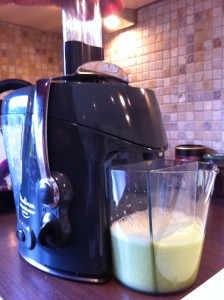
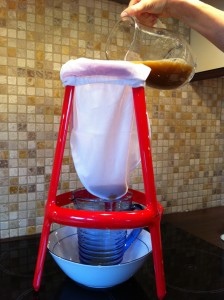


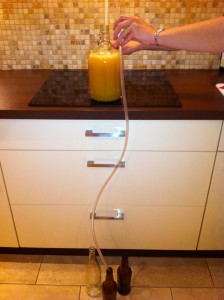
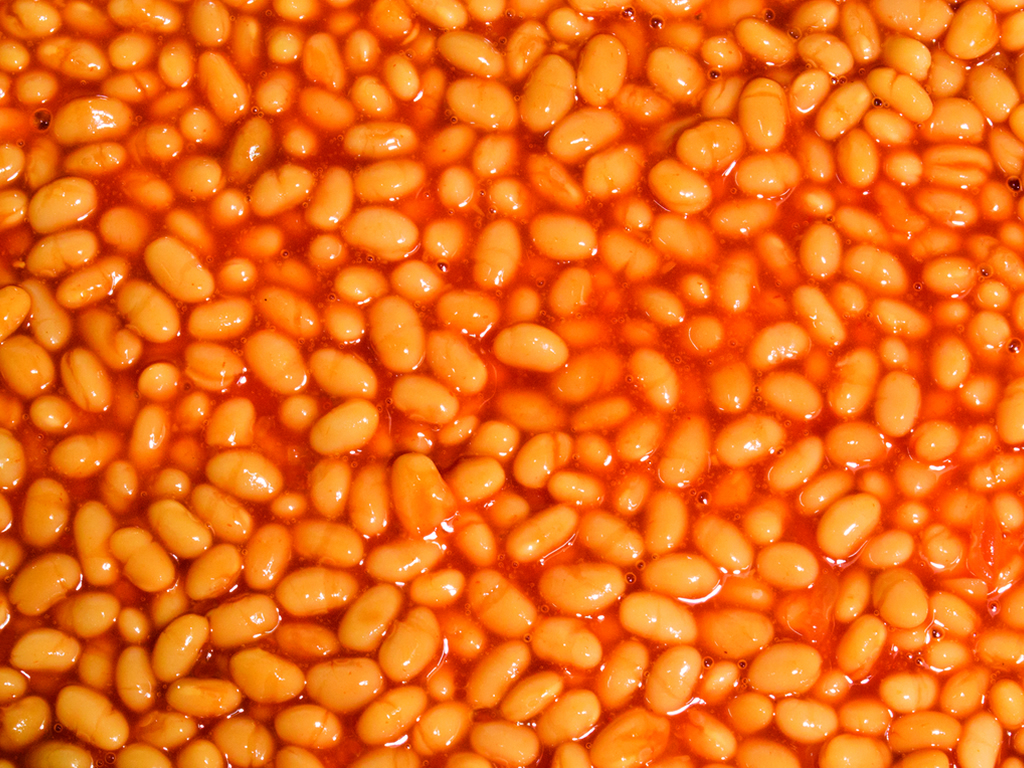


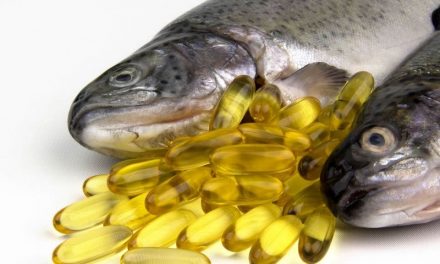
You must be logged in to post a comment.